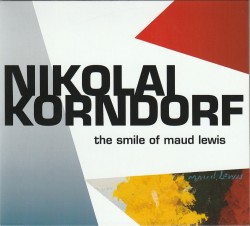 Russian composer Nicolai Korndorf (1947-2001) was a co-founder of the “new” ACM (association for contemporary music) in Moscow in 1990, but upon the dissolution of the Soviet Union he emigrated to Canada the following year. Russia’s loss was Canada’s gain and for a decade, until his sudden death in 2001, Korndorf was an associate composer of the Canadian Music Centre and an integral part of Vancouver’s contemporary music scene. The Smile of Maud Lewis (Redshift Records TK516 redshiftrecords.org), released to commemorate the 75th anniversary of the composer’s birth, features three works “that mark a creative highpoint and artistic rite of passage from his native Russia to Canada.” As the liner notes point out, all three are based on thematic material from earlier works. The booklet includes notational examples of these themes from Con Sordino for 16 strings and the included Lullaby, both dating from 1984, which became a sort of signature for Korndorf in his later works.
Russian composer Nicolai Korndorf (1947-2001) was a co-founder of the “new” ACM (association for contemporary music) in Moscow in 1990, but upon the dissolution of the Soviet Union he emigrated to Canada the following year. Russia’s loss was Canada’s gain and for a decade, until his sudden death in 2001, Korndorf was an associate composer of the Canadian Music Centre and an integral part of Vancouver’s contemporary music scene. The Smile of Maud Lewis (Redshift Records TK516 redshiftrecords.org), released to commemorate the 75th anniversary of the composer’s birth, features three works “that mark a creative highpoint and artistic rite of passage from his native Russia to Canada.” As the liner notes point out, all three are based on thematic material from earlier works. The booklet includes notational examples of these themes from Con Sordino for 16 strings and the included Lullaby, both dating from 1984, which became a sort of signature for Korndorf in his later works.
The disc begins with the title work, a tribute to the Nova Scotia folk artist who lived from 1903 until 1970. Korndorf said in an interview in 1998: “Discovering the art of Maud Lewis was the most important cultural experience for me since moving to Canada.” The Smile of Maud Lewis captures the sunny disposition and sense of wonder inherent in Lewis’ paintings, with a joyous ostinato of mallet percussion, celesta, flute/piccolo/recorder and full strings underpinning long, melodious horn lines. Somewhat reminiscent of early John Adams, with swelling cadences à la Philip Glass, the work builds dynamically Bolero-like throughout its quarter-hour length, only relaxing in its final minute to a glorious, gentle close. Conductor Leslie Dala captures both the exuberance and the nuance of this sparkling work.
Triptych for cello and piano opens abruptly with raucous chords in the cello which gradually resolve into an extended solo Lament in which Ariel Barnes is eventually joined by pianist Anna Levy. Levy begins the second movement Response with an ostinato once again drawing on Korndorf’s signature themes, this time supporting an extended melody line in the cello. Quiet pizzicato opens the final Glorification before arco cello and piano counterpoint gradually grow into celebratory ecstasy. Jane Hayes joins Levy for the final two tracks, Korndorf’s above-mentioned ebullient, though quiet, Lullaby for two pianos, and the gentle half-light, somnolent rains for piano duo by his former student Jocelyn Morlock, written in tribute to her mentor on the fifth anniversary of his death. These marvellous performances are a strong testament to the importance Nicolai Korndorf and his legacy.
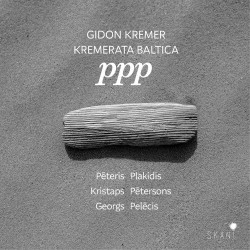 The title of this next disc, ppp (i.e. pianississimo), led me to expect a quiet and contemplative experience; it turns out, however, to be an acronym for the last names of the Latvian composers involved: Pēteris Plakidis, Kristaps Pētersons and Georgs Pelēcis. ppp features Gidon Kremer and his Kremerata Baltica (LMIC/SKANI 139 skani.lv) in works for various chamber combinations and for full ensemble. It begins with Little Concerto for two violins (1991) by Plakidis (1947-2019), a three-movement work performed by Kremer and Madara Pētersone, which reminds me of Bartók and Berio violin duos with its folk-like idioms and exuberance. Pētersons (b.1982) performs his own craggy Ground for double bass solo and is joined by Iurii Gavrilyuk and Andrei Pushkarev for π = 3,14 for two double basses, percussion and recording, a work somewhat suggestive of a sci-fi soundtrack. Pētersons’ Music for Large Ensemble is performed by Kremerata Lettonica, a nine-piece string ensemble supplemented with electric guitar played by the composer. This too seems to have electronic aspects, presumably executed by the guitarist since no recording is mentioned. It is in three movements, the last and lengthiest of which is nominally minimalist and features violin solos themselves reminiscent of electric guitar lines.
The title of this next disc, ppp (i.e. pianississimo), led me to expect a quiet and contemplative experience; it turns out, however, to be an acronym for the last names of the Latvian composers involved: Pēteris Plakidis, Kristaps Pētersons and Georgs Pelēcis. ppp features Gidon Kremer and his Kremerata Baltica (LMIC/SKANI 139 skani.lv) in works for various chamber combinations and for full ensemble. It begins with Little Concerto for two violins (1991) by Plakidis (1947-2019), a three-movement work performed by Kremer and Madara Pētersone, which reminds me of Bartók and Berio violin duos with its folk-like idioms and exuberance. Pētersons (b.1982) performs his own craggy Ground for double bass solo and is joined by Iurii Gavrilyuk and Andrei Pushkarev for π = 3,14 for two double basses, percussion and recording, a work somewhat suggestive of a sci-fi soundtrack. Pētersons’ Music for Large Ensemble is performed by Kremerata Lettonica, a nine-piece string ensemble supplemented with electric guitar played by the composer. This too seems to have electronic aspects, presumably executed by the guitarist since no recording is mentioned. It is in three movements, the last and lengthiest of which is nominally minimalist and features violin solos themselves reminiscent of electric guitar lines.
Three pieces from Fiori Musicali (2017-2022) by Pelēcis (b.1947) prove to be the most traditional on the album, the use of vibraphone as soloist with string orchestra notwithstanding. Pelēcis named his “blooming garden” after a collection of liturgical organ works by Girolamo Frescobaldi (1583-1643). The middle movement Dance of the Peonies has definite shades of Respighi about it. Cosmea Melancholy features Kremer as soloist, and once again we hear the vibraphone in an unusual context in this gloomy finale to a somewhat surprising disc.
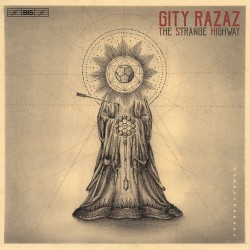 Speaking of string ensembles, the All-American Cello Band performs the title track of the CD The Strange Highway featuring music by Iranian-American composer Gity Razaz (b.1986) (BIS-2634 bis.se). (I feel compelled to point out that this so-called all-American band includes the Halifax-born Denise Djokic of the famed Nova Scotia musical dynasty, and also Icelander Sæunn Thorsteinsdóttir, although admittedly they both currently reside in America.) The Strange Highway takes its title from a poem by Chilean writer Roberto Bolaño: “You wish the angst would disappear / While rain falls on the strange highway / Where you find yourself.” Razaz says she was “moved by the potent sense of desolation and vulnerability expressed through the poem’s imagery.” The cello octet she has created, beginning with a driving, almost violent, moto perpetuo that gradually shifts into lyrical melancholia before coming full circle and effectively “capture[s] and recreate[s] these emotions.”
Speaking of string ensembles, the All-American Cello Band performs the title track of the CD The Strange Highway featuring music by Iranian-American composer Gity Razaz (b.1986) (BIS-2634 bis.se). (I feel compelled to point out that this so-called all-American band includes the Halifax-born Denise Djokic of the famed Nova Scotia musical dynasty, and also Icelander Sæunn Thorsteinsdóttir, although admittedly they both currently reside in America.) The Strange Highway takes its title from a poem by Chilean writer Roberto Bolaño: “You wish the angst would disappear / While rain falls on the strange highway / Where you find yourself.” Razaz says she was “moved by the potent sense of desolation and vulnerability expressed through the poem’s imagery.” The cello octet she has created, beginning with a driving, almost violent, moto perpetuo that gradually shifts into lyrical melancholia before coming full circle and effectively “capture[s] and recreate[s] these emotions.”
The next three works are for smaller forces – Duo for violin and piano, Legend of the Sigh for cello and electronics and Spellbound for solo viola – composed in 2007, 2015 and 2020 respectively. Francesca daPasquale and Scott Cuellar shine in the two movements of the Duo that explores contrasting aspects of a single melody. Inbal Segev is the dedicatee of Legend and he performs the challenging yet lyrical live and pre-recorded cello parts against an eerie and effective electronic backdrop. Katharina Kang Litton is the soloist in the haunting Spellbound, based on an original melody that “evokes the improvisatory lyricism of traditional Persian music.”
The final work, Metamorphosis of Narcissus for chamber orchestra and fixed electronics dates from 2011. Haunting again comes to mind as an apt descriptor, as solo woodwinds rise above a dense texture of strings, gongs and cymbals. Perhaps it is the surface similarity to George Crumb’s A Haunted Landscape that suggests the term. At any rate, Andrew Cyr and the Metropolis Ensemble are stellar in this culminating work on an excellent portrait disc. Razaz is definitely a young composer to keep an eye (ear) on.
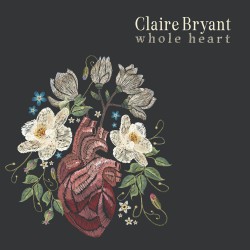 Cellist Claire Bryant’s Whole Heart (Bright Shiny Things BSTC-0178 brightshiny.ninja) represents both sides of her mandate as Assistant Professor of Cello and Coordinator for Community Engagement at the University of South Carolina. Bryant also directs the criminal justice initiative “Music for Transformation,” spearheaded by Carnegie Hall’s affiliate ensemble, Decoda, of which she is a co-founder. The seven works she has chosen, all by friends and colleagues, span 20 years of her career. Bryant says: “All these passionate works reflect love and the great human experience. Whole Heart is a reminder of the collective challenges we face and the resilience and strength that live inside each of us.”
Cellist Claire Bryant’s Whole Heart (Bright Shiny Things BSTC-0178 brightshiny.ninja) represents both sides of her mandate as Assistant Professor of Cello and Coordinator for Community Engagement at the University of South Carolina. Bryant also directs the criminal justice initiative “Music for Transformation,” spearheaded by Carnegie Hall’s affiliate ensemble, Decoda, of which she is a co-founder. The seven works she has chosen, all by friends and colleagues, span 20 years of her career. Bryant says: “All these passionate works reflect love and the great human experience. Whole Heart is a reminder of the collective challenges we face and the resilience and strength that live inside each of us.”
Andrea Casarrubios’ SEVEN was composed in 2020 and was inspired by the early pandemic ritual in New York City of citizens celebrating and encouraging frontline workers by banging pots and pans each evening at 7pm. Ayudame (2004) by Adam Schoenberg was the first piece that Bryant ever commissioned, back when she was a student at Juilliard. Schoenberg says the Spanish title translates as “’help me’ and refers, in part, to my struggle in composing the piece,” which also pushed the cellist with its juxtaposition of extreme virtuosity and high emotional output. They have both risen admirably to the challenge. Delta Sunrise by Jessica Meyer is a gentler, at times ethereal piece, inspired by the view from an early morning airplane journey after the composer’s inaugural trip to New Orleans. The other solo works are Varsha (Rain) by Reena Esmail, based on Hindustani ragas sung to beckon rain, and the playful And Even These Small Wonders by Tanner Porter which was “conceived in a trying time, but looks brightly towards the future.”
Bryant is joined by violist Nadia Sirota for the quietly boisterous Limestone & Felt by her longtime friend Caroline Shaw. Shaw and Bryant met as young children as summer campers and Suzuki collaborators. There’s lots of pizzicato and some rolling unison passages in this piece which explores two “contrasting, common textures – resonant, gleaming limestone and muted, soft felt.” The final work on this excellent and intriguing disc, Duo for violin and cello by Jessie Montgomery, features Ari Streisfeld, another longtime friend and colleague. The opening and closing movements, – Meandering and Presto – are virtuosic and playful, while the contrasting middle Dirge is melancholy and contemplative. Montgomery says “the piece is meant as an ode to friendship with movements characterizing laughter, compassion, adventure, and sometimes silliness.” A perfect ending to an enticing disc.
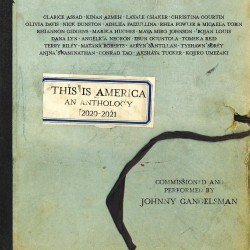 Violinist Johnny Gandelsman embarked on a similar, although more ambitious, voyage during the pandemic by commissioning works from a number of his colleagues that would “reflect in some way on the time we were all living through,” a time that was overshadowed not only by COVID-19, but also by escalating racism, police brutality and the ever-increasing effects of climate change. This is America – An Anthology 2020-2021 (In A Circle Records ICR023 inacircle-records.com/releases) is a 3CD set of works for mostly solo violin by some two dozen composers ranging from five to 24 minutes in length. I say mostly solo violin because some tracks involve voice(s) and/or electronics, and some call for Gandelsman to perform on alternative instruments including acoustic and electric tenor guitars and five-string violin. Clocking in at nearly three and a half hours, one might expect the set to grow tiresome after a while; but I must say there is more than enough diversity to command and hold attention, at least when consumed one disc at a time.
Violinist Johnny Gandelsman embarked on a similar, although more ambitious, voyage during the pandemic by commissioning works from a number of his colleagues that would “reflect in some way on the time we were all living through,” a time that was overshadowed not only by COVID-19, but also by escalating racism, police brutality and the ever-increasing effects of climate change. This is America – An Anthology 2020-2021 (In A Circle Records ICR023 inacircle-records.com/releases) is a 3CD set of works for mostly solo violin by some two dozen composers ranging from five to 24 minutes in length. I say mostly solo violin because some tracks involve voice(s) and/or electronics, and some call for Gandelsman to perform on alternative instruments including acoustic and electric tenor guitars and five-string violin. Clocking in at nearly three and a half hours, one might expect the set to grow tiresome after a while; but I must say there is more than enough diversity to command and hold attention, at least when consumed one disc at a time.
There are far too many tracks to enumerate here, but some of the highlights for me include the following. Disc one opens with O for overdubbed voices and violin by Clarice Assad. It is a hauntingly lyrical meditation on oxygen (“O”) referencing not only the respiratory distress and failure brought on by COVID-19 but also George Floyd’s last words “I can’t breathe.” Layale Chaker’s Sinekemān, in which the solo violin evokes the spirit of the Ottoman ancestor of the violin (sinekemān) characterized by its seven sympathetic strings, is a study on solitude, “an ongoing flux of moments of self-sufficiency and struggle, lucidity and confusion, power and despair, already depicted by the aloneness of the solo instrument.” Nick Dunston’s percussive and scratchy Tardigrades was inspired by the phylum of eight-legged segmented micro-animals that can survive lack of food or water for up to three decades, withstand extreme temperatures and have even been reported to be able to survive the vacuum of outer space (although those on board Israel’s Beresheet mission, which crash-landed on the moon in 2019, are thought not to have survived).
Disc two begins gently with Gandelsman singing and whistling while strumming a tenor guitar on Marika Hughes’ With Love From J, commemorating the life of Jewlia Eisenberg with the lyric “…The sky above us / the ground below / 360 support around us / cut discursive thought. Can you hear / What we’ve learned / Through the years? That love, sweet love / Reminds us / What to listen for.” Angélica Negrón’s A través del manto luminoso (Through the luminous mantle) takes its inspiration from dark-sky photographs of the heavens taken in Puerto Rico. It juxtaposes the acoustic violin with synthetic sounds meant to replicate audio recordings of ancient stars made using data from NASA’s Keppler/K2 missions. The eerie sounds and the “lonely” violin suggest the depths of space and the wonder of the universe. The minimalist pioneer Terry Riley is one of the few composers on this anthology with whose music I would have said I am familiar. But I must say that Barbary Coast 1955 for five-string violin is unlike anything else of his that I have heard. Riley gives a blow-by-blow description of the genesis and development of the work in his 11-part program note, including a number of false starts and rejected ideas. What we are left with is a kind of tango-tinged South American melody “that might have found itself drifting into the weed-scented room of a Beat poet” in North Beach (San Francisco’s “Barbary Coast” section) in the 1950s. This slowly morphs into a rollicking Bach-like quasi-contrapuntal section before gradually winding down. Quite a striking work.
Disc three begins with the brief Stitched by Matana Roberts that seems to pick up right where Riley’s piece left off, opening very quietly with a longing melody that develops gently over its four-and-a-half-minute length before fading. With a seamless segué, Aeryn Santillan’s Withdraw is a work “reflecting on the state of society in 2020 through an intimate lens.” These two relatively short works are followed by more extended pieces by Tyshawn Sorey – For Courtney Bryan, strangely the only piece to not have a contextual program note in the otherwise quite detailed booklet – Anjna Swaminathan, Conrad Tao and Akshaya Tucker. The disc concludes with Breathe by Kojiro Umezaki, another meditation on the “world being brought to its knees by an inconspicuous peril replicating exponentially (and paradoxically) through the life-giving/sustaining act of breathing.”
Throughout this impressive undertaking Gandelsman rises to all the myriad challenges, be they technical, stylistic or emotional. This is a compelling snapshot, or rather compendium, of America in the depths of a very troubled time, expressing anger, remorse, anguish and, most importantly, hope. Kudos to all concerned, especially Gandelsman who conceived the project and brought it to glorious fruition.
We invite submissions. CDs, DVDs and comments should be sent to: DISCoveries, WholeNote Media Inc., The Centre for Social Innovation, 503 – 720 Bathurst St. Toronto ON M5S 2R4.
David Olds, DISCoveries Editor
discoveries@thewholenote.com



